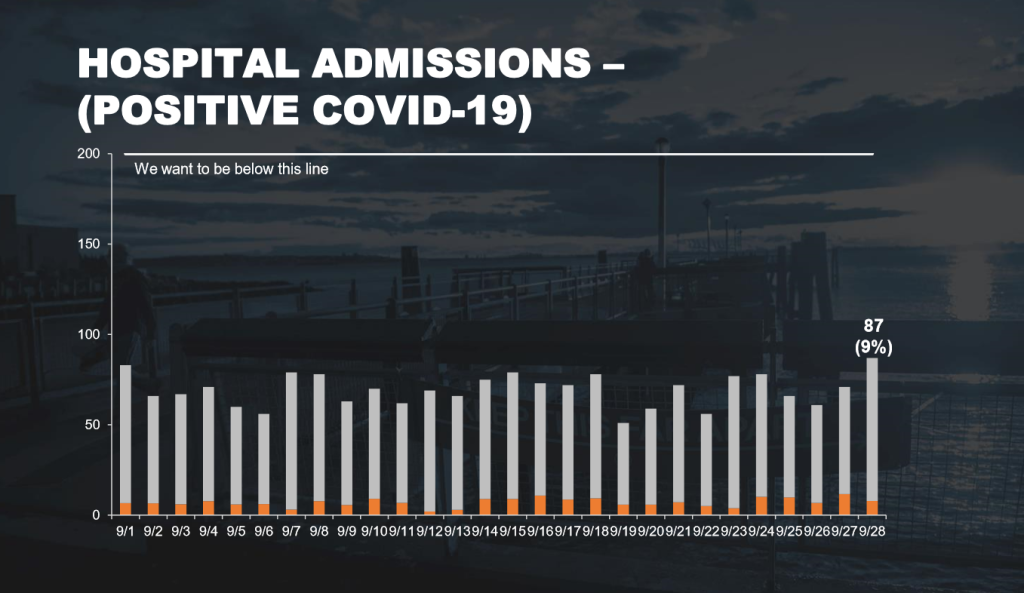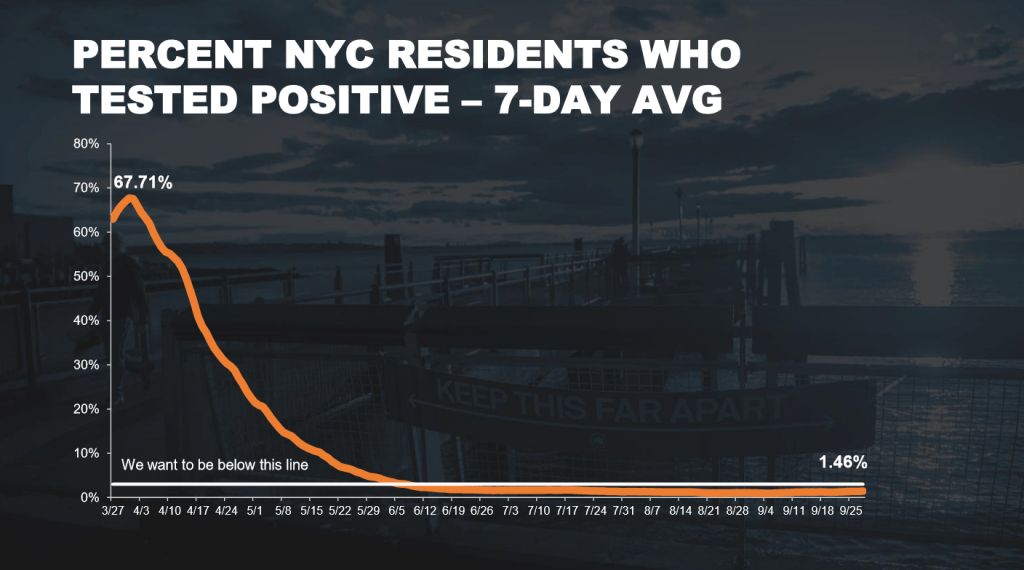What to Know
- COVID clusters in Brooklyn, Queens and Rockland and Orange counties continue to grow at a rate far outpacing the city and state average; Gov. Andrew Cuomo said reopening rollbacks are possible without improvement
- On Wednesday, the governor said the state's 20 hotspot codes hit a COVID-19 positivity rate of 5.5%, more than 5x the state average; the ones in Brooklyn and Queens are starting to affect the city's overall positivity rate
- The concerns come as indoor dining returns in New York City Wednesday for the first time in half a year; public schools also complete their staged reopening this week, welcoming about a half a million students in person
Indoor dining returns in New York City Wednesday for the first time in more than half a year, a boon for long-struggling restaurant owners and staff and yet another sign of progress for the former U.S. COVID epicenter even as it battles soaring infection rates in more than a half-dozen neighborhoods.
New York City COVID hospital admissions (87) and seven-day average daily cases (354) both hit September highs Wednesday, according to data Mayor Bill de Blasio revealed at his daily briefing. The daily positivity rate fell below 1 percent after topping 3 percent Tuesday for the first time in months, though the seven-day rolling positivity rate, which represents a fuller picture, ticked up a bit higher.

Hospital admissions for COVID and the daily case average both hit month-long highs Wednesday, city data shows.

Of the nine ZIP codes most closely being watched in the five boroughs, seven saw noticeable increases in positivity rates since the most recent update Monday. One saw a slight decline while another remained flat. Those nine ZIP codes account for 25 percent of the city's positive cases over the last two weeks.
Compared with some parts of the country, these numbers are still relatively low -- and the city's overall infection rate remains one of the lowest in the nation. At the same time, de Blasio says the goal is to prevent the kind of surge that some other major cities have experienced -- at devastating cost -- over the last few months.

These nine ZIP codes have accounted for 25 percent of all cases citywide over the last two weeks.
Gov. Andrew Cuomo ripped New York City officials, along with those in Rockland and Orange counties, in a fiery news briefing Tuesday, blaming local governments for the clusters, which he says mark a failure of compliance and enforcement.
At this point, the governor described the problem as a "cluster problem," albeit the largest one he said the state has had to address since the one in New Rochelle in March, which marked the first "superspreader event" in New York for COVID-19. Cuomo said the treatment for clusters must be aggressive -- and warned they could evolve into community spread without immediate containment measures. If the clusters can't be contained, Cuomo said reopening rollbacks are possible.
Right now, the 20 hotspot ZIP codes in the entire state, which include the ones in Orange and Rockland counties as well as in the city, are averaging an infection rate more than five times the statewide average, Cuomo said Wednesday. Those 20 ZIP codes account for 23 percent of statewide cases despite representing just 6 percent of New York's population, he added. Most are in Orthodox communities.
Cuomo said he spoke with the leaders of some of those Orthodox communities Wednesday morning and described the conversation as productive. He said the state will hold a follow-up discussion with them later Wednesday to devise a comprehensive action plan and means of carrying that out.
A day earlier, de Blasio described the Brooklyn and Queens clusters as cause for "extreme concern," announcing mask refusal fines effective immediately amid ongoing, targeted outreach efforts. Asked why he didn't implement more severe restrictions, like closing private schools and non-essential businesses, de Blasio said the city was reserving the right to evaluate the need for stronger steps -- but he warned more stringent ones may come Wednesday if the data warranted.
He didn't immediately announce new severe restrictions at his daily briefing Wednesday, saying it appeared intense communication and community outreach was showing some effect. Police presence and inspections are both stepped up.
Daily Percentage of Positive Tests by New York Region
With all of New York state in some phase of reopening, Gov. Andrew Cuomo is shifting his focus to monitoring test results on a daily basis across each region to identify potential hotspots before they emerge. Here's the latest tracking data by region. For the latest county-level results statewide, click here
The clusters are starting to affect the city's daily positivity rate overall, de Blasio said. City data on that metric topped 3 percent Tuesday for the first time in months, though fell below 1 percent again Wednesday. That said, the seven-day rolling average positivity rate, which represents a fuller picture, ticked up to 1.46 percent Wednesday from 1.38 percent a day earlier. If the city's seven-day positivity rate hits 3 percent, the mayor has said that would warrant the immediate re-closure of public schools citywide.

If the seven-day rolling positivity average hits 3 percent, schools will be shut down again, the mayor has said.
Up to 80 public schools located near or within the affected areas could be temporarily closed sooner if the cluster situation doesn't improve, given their proximity to the hotspot neighborhoods, officials said. The largest teachers' union once again put the city on notice: Fix the problem or the schools get closed.
"This is an inflection point. We have to take serious action and we will be escalating each day depending on what we see on the ground," de Blasio said, urging people in the affected ZIP codes to get tested to give a truer picture.
Indoor dining is set to return Wednesday in New York City at 25 percent capacity; the mayor said Tuesday that would proceed as scheduled. NBC New York's Ida Siegal reports.
Areas of Concern
The cluster areas in Brooklyn, Queens, Rockland and Orange counties are primarily Orthodox communities. Cuomo said he planned to meet with Orthodox leaders in the most affected areas to discuss compliance and next steps, though hesitated to single out any particular group as exceedingly problematic.
“This is a concern for their community,” Cuomo said. “It’s also a public health concern for surrounding communities. And I’ve said from Day One, these public health rules apply to every religion. Atheists. It just applies to every citizen in the state of New York, period.”
In Rockland County, the primary areas of concern are Monsey and Spring Valley; in Orange County, it's ZIP code 109250, while Cuomo cited Brooklyn ZIP codes 11219, 11210, 11204 and 11230 and Queens' 11367 as high infection rate areas.
De Blasio provided an update on positivity rates Wednesday for the nine key ZIP codes of concern. Seven of them increased from the Department of Health's most recent update on Monday:
- Gravesend/Homecrest (6.92%)
- Midwood (5.64%),
- Kew Gardens (3.31%)
- Edgemere/Far Rockaway (4.91%),
- Borough Park (6.23%),
- Bensonhurst/Mapleton (6.05%),
- Sheepshead Bay (4.05%),
- Flatlands/Midwood (4.73%)
- Kew Gardens Hills/Pomonok (3.60%)
Four areas being watched closely also saw upticks from the previous report:
- Rego Park (2.64%)
- Kensington/Windsor Terrace (2.72%)
- Brighton Beach/Manhattan Beach/Sheepshead Bay (2.85%)
- Williamsburg (1.89%)
NBC New York's Tracie Strahan, Katherine Creag and Marc Santia report.
While indoor dining does start Wednesday despite the warning signs, it could be shelved once again soon if the clusters turn into larger outbreaks, officials have warned. As it stands, restaurants can only open indoors at 25 percent capacity.
In addition to social distancing and mask-wearing, diners must agree to temperature checks and to submit contact tracing information to the restaurant. The mayor reminded restaurants Wednesday to abide by the rules on capacity, personal protective equipment and other COVID precautions. While indoor dining also resumes Wednesday in the hotspot ZIP codes, rigorous inspections will be conducted, the mayor said, and any issue could result in immediate summonses.
"again" - Google News
September 30, 2020 at 09:51PM
https://ift.tt/30knDcq
NYC Clusters Worsen Again as Return of Indoor Dining, School Fuel Anxiety; Hospitalizations Rise - NBC New York
"again" - Google News
https://ift.tt/2YsuQr6
https://ift.tt/2KUD1V2
Bagikan Berita Ini














0 Response to "NYC Clusters Worsen Again as Return of Indoor Dining, School Fuel Anxiety; Hospitalizations Rise - NBC New York"
Post a Comment